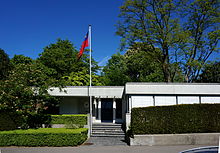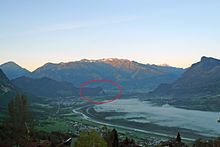Liechtenstein-Swiss relations

|
|
|
|
|
| Liechtenstein | Switzerland |
Due to the geographical, economic, political, cultural and social proximity of Liechtenstein to Switzerland , relations between the two countries are extremely close. The principality has been part of the Swiss customs area since 1923 . The national currency has been the Swiss franc since 1924 .
Liechtenstein and the Confederation until 1914

In 1460 the Confederates took possession of the County of Sargans and thus became Liechtenstein's immediate neighbors. Since the Old Zurich War , the area of Liechtenstein was part of a buffer zone between federal and Habsburg areas of influence. From 1497 to 1615 the dominions of Gams , Maienfeld , Werdenberg and Sax-Forstegg , which border on Liechtenstein , became federal subject areas .
An uprising by the Werdenberg subjects caused the Vaduz bailiff to break off the bridge over the Rhine, which was under construction, for fear of the uprising spreading in 1720. In the coalition wars between neutral Switzerland and Liechtenstein from 1794 onwards, a border barrier that seriously burdens the Liechtenstein population existed. During the collapse of the old Swiss Confederation in 1798, the Abbot von Pfäfers and the canons of Schänis Abbey fled to Liechtenstein.
In 1838 Liechtenstein concluded a free movement agreement with the Swiss Confederation , which enabled Liechtenstein seasonal workers to work in Switzerland. The customs treaty concluded with Austria in 1852 led to years of conflict. There were five Rhine crossings into Switzerland, but Austria refused to operate more than two customs posts. In 1862, after difficult negotiations, Liechtenstein was able to set up two more customs offices. From 1868 Rhine bridges were available for traffic with Switzerland , and in 1872 the Feldkirch – Buchs railway line was opened. The Swiss-Austrian trade agreements from 1868 onwards, which were ratified with the consent of Liechtenstein, made border traffic easier. The ties that arose between the two countries between 1852 and 1914 formed the basis for Liechtenstein's turn to Switzerland after the First World War.
First and Second World War

In the First World War, Switzerland recognized unlike the countries of the Entente the neutrality of Liechtenstein and supported until 1916, the Liechtenstein national supply by food deliveries. To ensure economic survival, a reorientation towards Switzerland took place after the war. In 1919, Liechtenstein terminated the customs treaty with Austria and started negotiations with Switzerland, which led to the postal treaty in 1920 . In 1923 the Customs Union Treaty was signed, which joined Liechtenstein to the Swiss economic and customs territory from January 1, 1924. In addition, Liechtenstein introduced the Swiss franc as its currency in 1924 - a formal currency agreement was not concluded until 1980. The customs treaty enabled the Liechtenstein economy to recover in the interwar period and was one of the most important factors in the economic upturn after the Second World War.
After Austria was annexed to the German Reich in 1938, Switzerland granted loans and made economic commitments to support Liechtenstein's sovereignty. In return, the neighboring country expected a commitment to the existing state treaties and in 1939 the assignment of the Ellhorn, which is important for Swiss national defense . The impending war brought the two countries closer together. During the Second World War , Liechtenstein was fully integrated into the Swiss war economy . The Swiss Federal Council decided not to defend the principality in the event of a German attack. In 1948, Switzerland forced Liechtenstein to sell the Ellhorn.
Post-war, present
Liechtenstein works closely with Switzerland in the area of social insurance. In 1954 the first agreement was concluded on old-age and survivors' insurance (AHV), in 1969 on family allowances and in 1979 on unemployment insurance .
The operation of the St. Luzisteig arsenal by the Swiss Army repeatedly led to problems, especially in the Balzers community . The shooting exercises represented a noise nuisance and led u. a. 1960 and 1985 on forest fires.
As a result of the economic boom after the Second World War, Liechtenstein directed its foreign policy to other countries. In 1970, Hereditary Prince Hans-Adam asked to get out of Switzerland's “backpack”. The customs treaty was adapted to allow Liechtenstein to join the European Free Trade Association (EFTA) in 1991 and the European Economic Area (EEA) in 1995 .
Due to the sharp rise in the proportion of foreigners in Liechtenstein, the mutual freedom of establishment introduced in 1941 was partially revoked in 1981. With 3,645 people in 2017, the Swiss form the largest group of foreigners in Liechtenstein. Conversely, at the same time in 1729, Liechtenstein residents were living in the neighboring country. Since 2005 there for Liechtenstein in Switzerland regain full movement of persons , resident in Liechtenstein Swiss are the EEA equated -Bürgern.
Healthcare, Education, Church

Due to its small size, Liechtenstein is dependent on the use of facilities in Switzerland in various areas. The Liechtenstein State Hospital works together with the Cantonal Hospital of Graubünden . Because of the proximity, many Liechtenstein residents seek treatment at the Grabs Hospital . Based on the Customs Union Treaty, various Swiss laws from the field of health care apply in Liechtenstein, including the Therapeutic Products Act and the Epidemics Act.
Many Liechtensteiners complete a large part of their training at Swiss universities, technical colleges and vocational schools . The vocational training system corresponds to that in Switzerland. Since 1976, the Liechtenstein Matura has been equivalent to the Swiss one. For example, the Principality participates in the Interstate University of Technology Buchs NTB , which was founded in 1968 , is an associate member of the Swiss Conference of Educational Directors (EDK) and joined the Swiss University Concordat in 1981 .
In the area of civil aviation and surveying, there is close cooperation with the Swiss Federal Office for Civil Aviation and the Swiss Accident Investigation Center (SUST) and with the Federal Office for Topography swisstopo. As early as 1937/38 the country was connected to the Swiss triangulation network. The small state has been an associated member of the Eastern Switzerland Police Concordat since 2003 . The population in emergencies is supplied in cooperation with the Swiss Federal Office for National Economic Supply .
In 1997, when the Archdiocese of Vaduz was separated from the Diocese of Chur, a 1500-year bond ended in the church sector .
Web links
swell
- Patrick Sele, Gerhard R. Hochuli, Donat Büchel: Switzerland. In: Historical Lexicon of the Principality of Liechtenstein . December 31, 2011 .
Individual evidence
- ^ Treaty of March 29, 1923 between Switzerland and Liechtenstein on the connection of the Principality of Liechtenstein to the Swiss customs territory. March 29, 1923, accessed June 21, 2020 .
- ^ Gerhard R. Hochuli: Switzerland. In: Historical Lexicon of the Principality of Liechtenstein . December 31, 2011 .
- ^ Treaty of March 29, 1923 between Switzerland and Liechtenstein on the connection of the Principality of Liechtenstein to the Swiss customs territory. March 29, 1923, accessed June 21, 2020 .
- ^ A b Donat Büchel: Swiss Army. In: Historical Lexicon of the Principality of Liechtenstein . December 31, 2011 .
- ↑ Population statistics on the website of the Liechtenstein Statistical Office, accessed on July 10, 2019.
- ↑ Foreigners statistics December 2017 on the website of the Swiss State Secretariat for Migration SEM, accessed on July 10, 2019.
- ↑ Internal medicine on the Liechtenstein State Hospital website, accessed on July 10, 2019.
- ^ Hospital region Rheintal Werdenberg Sarganserland is reorganized on the website of the hospital associations of the canton St. Gallen, February 19, 2014.
- ↑ Schiess Rütimann, Patricia M .: The customs contract and the measures to combat the coronavirus. How Swiss law is applied in Liechtenstein via the Customs Union Treaty and Epidemics Act . Ed .: Liechtenstein Institute. Bendern April 2020, p. 44 , doi : 10.13091 / li-ap-65 .
- ↑ The overview of the Swiss law applicable in Liechtenstein can be found at: https://www.llv.li/inhalt/172/amtsstellen/anwendbaren-schweizer-recht .
- ↑ Civil aviation on the website of the state administration, accessed on March 15, 2019.
- ^ Editing: Survey. In: Historical Lexicon of the Principality of Liechtenstein . December 31, 2011 .
- ↑ Herbert Wille: Police. In: Historical Lexicon of the Principality of Liechtenstein . December 31, 2011 .
- ^ Office for Civil Protection on the website of the State Administration of the Principality of Liechtenstein, accessed on March 15, 2019.


